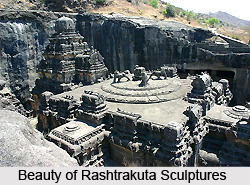 The features of Rashtrakuta sculpture reflect the Dravidian style. The Rashtrakuta which was a royal dynasty contributed handsomely to the development of the art and architecture of that age. This royal dynasty ruled large parts of the Indian Subcontinent between the sixth and the tenth centuries. The origin of Rashtrakuta dynasty has been a topic of debate among the historians. Some scholars do say that they belong to a Kshatriya race who gave their name to Maharashtra. However, it can be determined that they established their empire over the ruins of Chalukyas.
The features of Rashtrakuta sculpture reflect the Dravidian style. The Rashtrakuta which was a royal dynasty contributed handsomely to the development of the art and architecture of that age. This royal dynasty ruled large parts of the Indian Subcontinent between the sixth and the tenth centuries. The origin of Rashtrakuta dynasty has been a topic of debate among the historians. Some scholars do say that they belong to a Kshatriya race who gave their name to Maharashtra. However, it can be determined that they established their empire over the ruins of Chalukyas.
The features of Rashtrakuta sculpture are apparent in the rock cut architectures. The main structures built during the rule of the Rashtrakutas were the rock cut caves. The caves at Elephanta and Ellora nestled in Maharashtra bear testimony to the artistic wizardry of the Rashtrakutas. It is amazing to note that in the Elephanta caves, a series of elephants carved on the lower pedastal create an illusion that they are carrying the Kailas. Also, it is interesting to observe that out of the 34 caves at Ellora, twelve belong to the Buddhists. In fact, the caves here are dedicated to several sects including Buddhist, Jain, Shaiva and Vaishnava.
According to historical sources, the Buddhist caves have been redone by the Rashrtrakutas. The sculpture of Kailasanatha temple is awe inspiring. Its striking proportion, elaborate workmanship and architectural content are the notable examples of Dravidian architecture. This monolithic structure is considered one of the finest caves in India. The monolithic cave temples are carved out of a single huge rock. These cave temples have been dug from the top and the sculptors had gradually moved downwards.
The sculptures that adorn the monuments of the Rashtrakutas have been drawn from Hindu mythologies. The figure sculptures of dancers, musicians, gods and goddesses from Hindu Puranas, nymphs and others are common on the outer walls of these rock cut caves. The rock cut architecture of these monuments has earned them a place in the UNESCO World Heritage Site. The sculpture of Kasivisvesvara Temple is also worth checking out. This has also been built by following the vocabulary of the Rashtrakuta architecture.



















